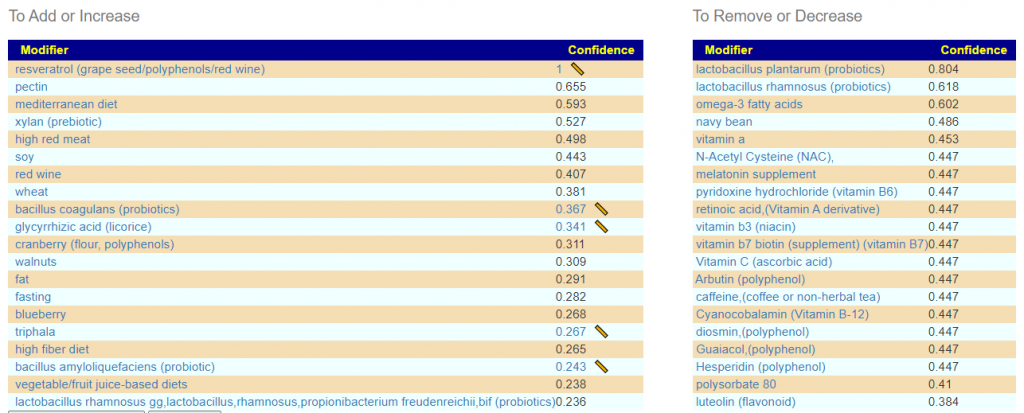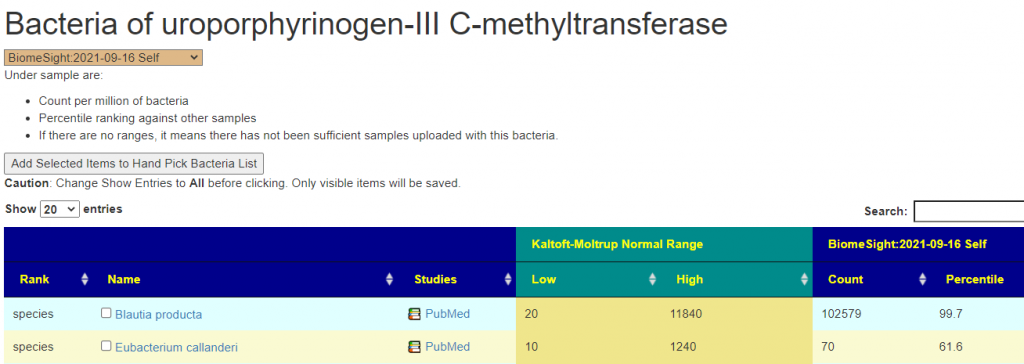A reader asked for a review. The reader had a prior sample taken 6 weeks before and specific treatments between
I took Ivermectin for 4 days during this month – one per day 12mg. I am treating yeast with nystatin 5,000 units 2 times per day for one month. I hope the die-off may have made room for bacteria to grow. I still feel crappy. I stopped lactobacillus ( I tried Lactobaciullis grains from Keith during that time. too much bloating), and started Akkermansia muciniphila and very recently some Bifidobacterium. I had cut back on dairy earlier (using soy milk and oat milk instead). I also took Sporonax (Itraconazole) antifungal about 5 times and Valtrex 500 mg 8 times.
My starting point (before looking at the samples) is to look at what we know about the impact of these items.
- nystatine,(prescription) – of the 1286 bacteria listed, it decreases ALL of them
- ivermectin,(prescription) – of the 1286 bacteria listed, it decreases ALL of them
- itraconazole,(prescription) – of the 1286 bacteria listed, it decreases ALL of them
- valacyclovir hydrochloride,(prescription) (Valaciclovir, Valtrex, Zelitrex) – of the 1286 bacteria listed, it decreases ALL of them
So the expectation of making room for bacteria appears very reasonable. The unfortunate aspect is that among the causalities are: Lactococcus, Lactobacillus, Bifidobacterium and Akkermansia muciniphila. So the question arises, will the good or the bad grow back faster?
What changed?
I first checked the common bacteria that most people are usually concerned with (cited above) and then will look at what increased. One item is of definite concern 💥, (class) Fusobacteria
| Bacteria | Before | Latest |
| (genus) Lactobacillus | 1150 | ⇲140 |
| (genus) Lactococcus | 380 | ⇲180 |
| (genus) Bifidobacterium | 640 | ⇲340 |
| (species) Akkermansia muciniphila | 50 | ⇲30 |
| (species) Hathewaya histolytica | 220 | ⬆️869 |
| (class) Negativicutes | 10090 | ⬆️14820 |
| (class) Gammaproteobacteria | 790 | ⬆️1500 |
| (class) Bacteroidia | 267,859 | ⬆️322,050 |
| (class) Chitinophagia | 20 | ⬆️70 |
| (class) Fusobacteria | 55280 | ⬆️90210 💥 |
| (class) Coriobacteriia | 3160 | ⇲670 |
| (class) Sphingobacteriia | 1010 | ⇲270 |
Checking back with what is decreased by the drugs, at the family level
- (family) Oceanospirillaceae had the largest increase, and is not listed as one that decreases
- (family) Clostridiales Family XIII. Incertae Sedis, the same
- (family) Clostridiales incertae sedis the same
- (family) Acidaminococcaceae the same
- (family) Hungateiclostridiaceae the same
- (family) Alcaligenaceae the same
- (family) Fusobacteriaceae is listed as a should decrease, but it increased — it should be noted that this was very high in the prior one and more resistant and thus increased when the vacuum was created,
- (family) Bacteroidaceae the same
It was interesting to note the many of the bacteria that were abnormally high (95%ile) stayed the same or increased. The fact that they were high implies more aggressive strains (and possibly more bacteriocin and antibiotic resistant).
Looking at species that are outside of the KM range, we have the following being excessively high
- (species) [Ruminococcus] gnavus
- (species) Bacteroides denticanum
- (species) Blautia glucerasea
- (species) Blautia producta
- (Species) Propionigenium modestum
Note that other Blautia species were abnormally low. These are already accounted for in the suggestions.
Looking further back
“I believe vancomycin started the problem to flare when I took in a couple of years ago. I also had my first covid shot of June 26, 2021 with immediate bad reactions and probably made worse since.
- vancomycin (antibiotic) Increases some and decreases other
The very high Fusobacteria identified above is one bacteria that would be decreased by this antibiotic (so this is unlikely that this the cause of this being high).
The following are items that have been reported to increase this bacteria:
Suggestions
I expect the suggestions to be very similar because the items high before stayed high (i.e. no change)



There was one additional probiotic suggested from the latest sample and it had a far stronger impact then the older ones.


The KEGG suggested probiotics are the same ones, just a higher value because of an increased deficiency in enzymes being produced by the microbiome.


Bottom Line
The data base correctly predicted the likely decrease of the common bacteria assumed important for health. Those that did no reduce were either not effected, more resistant strains (inferred from being high numbers prior)
What I found interesting was the absence of most probiotics (lactobacillus and bifidobacterium) in the safe suggestions, except for bifidobacterium breve. Securil (Propionibacterium freudenreichii) probiotic came in very strong.
- Giloteaux65 found that supplementation with the bifidogenic substance Propionibacterium freudenreichii improved butyrate levels, which induces an anti-inflammatory cascade [2017]
- One of particular interest is found in the product Securil and is called – Propionibacterium freudenreichii, which produce propionic acid, a natural biological acid that benefits the bifidus flora. [2010]
- More studies here
Note that this is specific for this person. Suggestions will be different for other peoples taking the same items.
Reader’s Desire
“I was also trying to get my methylation working better and taking b vitamins again. Could it be the b vitamins?”
The B-vitamins are suspect for the high levels of Fusobacteria. We should also note that are the to avoid list we see many of the B vitamins which suggests that much of the dysbiosis may be vitamin B related.
Concerning methylation, I usually see what enzymes are involved by checking with the Kyoto Encyclopedia of Genes and Genomes, And then check the KEGG Enzyme Outliers report. This report had a very high 470 items listed!!

Drilling down into a few, we see some of the causes

This value is beyond the K-M range and thus suggestions to correct this is automatically captured in the above suggestions.
Recent Comments